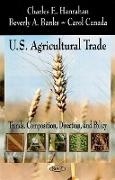- Start
- U.S. Agricultural Trade
U.S. Agricultural Trade
Angebote / Angebote:
Leading markets for U.S. agricultural exports are Canada, Mexico, Japan, the European Union, China, South Korea, and Taiwan. The United States dominates world markets for corn, wheat, and cotton. Brazil has overtaken the United States as the world's leading supplier of soybeans and is the world's leading supplier of beef and poultry to world markets. The U.S. share of world beef exports has declined since the discovery of a cow infected with "mad cow disease" in the United States in 2003. The United States, European Union, Australia, and New Zealand are dominant suppliers of dairy products in global agricultural trade. Most U.S. agricultural imports are high-value products. For some imports (grains, meats, horticultural products), similar products are produced in the United States, production of other categories of imports (bananas, coffee, cocoa) is very limited. The biggest import suppliers are the European Union, Canada, and Mexico, which together provide 57% of total U.S. agricultural imports. Australia, Brazil, New Zealand, Indonesia, and Colombia are also major suppliers of agricultural imports to the United States. Among the fastest-growing markets for U.S. agricultural exports are Canada and Mexico, both partners with the United States in the North American Free Trade Agreement (NAFTA). U.S. agricultural exports to China, recently a member of the World Trade Organization, have grown at an annual rate of 16% since 1992. Both the EU and the United States subsidise their agricultural sectors, but overall the EU outspends the United States five to one. Recent reforms of the EU's Common Agricultural Policy shift substantial spending into direct income support decoupled from production and into rural development. Canada supports some sectors (e.g., dairy and poultry) more than others. Australia provides less support to its agriculture. Export subsidies are more important in the EU than in the United States, border measures (tariffs) are more important in Canada than in either the United States. Australia operates a mix of trade measures. The United States is the dominant supplier of foreign food aid, followed by the EU, Canada, and Australia. U.S. and other major food aid donors provide commodities for emergency relief or development assistance.
Folgt in ca. 10 Arbeitstagen
